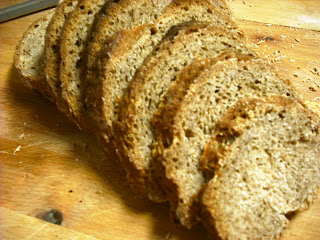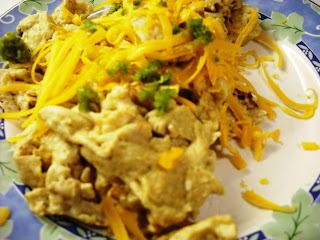 You'd think that a post with the title "Cheap, Easy" and "Bread" -- well, it would inspire me with my most risque content, my most glittery, tube-toppy, lucite heeled (with a slot for tips!), dominatrix-centered prose.
You'd think that a post with the title "Cheap, Easy" and "Bread" -- well, it would inspire me with my most risque content, my most glittery, tube-toppy, lucite heeled (with a slot for tips!), dominatrix-centered prose. Yeah, okay, it did. I am now picturing Denzel Washington in drag on the Vegas strip, leaning over in a mini-skirt, his stockings just run enough so that we know he's cheap (as if the tawdry pink tube top and multiple gold necklaces, and well -- those SHOES -- didn't already say that loud and clear) -- leaning over, I say, at the window of a long, dark BMW or Lincoln, and the window snicks down, and Denzel says, not even trying to disguise his voice, "So, you want a date?"
And the man in the car says: "Sure. If you're really Denzel."
Denzel flashes his actor's union card or something, looking over his bare shoulder for cops. Oh, and he's chewing gum. Blue gum. He also cracks it.
The guy in the car says: "I'm all for a date, so long as you're easy and cheap."
Denzel, with his long, fake fingernails, each one with the American flag painted on it, reaches in and pops open the door with one hand. He's carrying a clearly knock-off Gucci from the 1990s. He slides onto the seat, the window snicks up, the car drives away somewhere where the most hideous lights reflect off the back window.
Cheap. Easy. You knew I'd go there. You just didn't know I'd take Denzel down with me.
You won't underestimate me again, will you?
So. To the point: when, exactly, did bread become difficult?
That is, when did we start letting people make our bread for us, and then letting them jack the price up on us until, at my local Publix, a loaf of palatable fresh bread costs $3.00--10 times more than it costs to make it at home? "Good" bread is now about $5.00 a pound. Ridiculous. Ridiculous!
All you need is fifteen minutes every two weeks to mix up a batch of this; a pizza stone (find one at a garage sale); an oven; some water; and the bottom of a broiling pan.
For ingredients: whole wheat flour, white flour, vital wheat gluten, water, salt, yeast, spray grease.
You will not be required to knead.
Yes, you heard that right.
Here's how it goes. In a bucket that holds at least five quarts and that you can cover LOOSELY (since yeast breathes) -- I got a big plastic container at Valdemart and cut a hole in the top -- mix the following:
(NOTE: To measure use single cup cup measures so you don't get too much flour. Pack the cups loosely.)
4 c whole wheat flour, packed LOOSELY in the cup measure.
3 1/2 c bread flour, packed LOOSELY in the cup measure.
1 1/2 TBSP (2 packets) of yeast
1 1/2 TBSP salt (kosher or sea is better, but any will do)
1/4 c vital wheat gluten
When these are mixed together, add:
4 cups of water at about 100 degrees. I get this by nuking my winter tap water for about 30 secs. Until you get a feel for how hot this is (it barely registers as warm when you touch it), you might want to use a thermometer.
Mix with your hands or a large wooden spoon. It should be very sticky, but not runny and not dry. Mix until all the flour's been taken up into the dough. Since my bin is clear, I can see this pretty well, but before I had that, I used a big bowl and just lifted the dough with my hands to make sure there was no loose flour underneath where it likes to hide.
Cover loosely and stand in a corner somewhere you can forget it. Forget it for at least three-four hours.
When you get back to remembering about it, don't touch it, punch it down, nothing. NOTHING. Just cover it loosely and put it in the fridge. You want it tightly enough covered that it won't dry, but loosely enough that the yeast can breathe. Again, I just cut a slit in the top of my bin here, and it works beautifully. Leave it alone for about 24 hours or more.
When you're ready to bake:
Sometime in the next two weeks, after at least 24 hours in the fridge, get out a cookie sheet and grease it lightly. Take the container of dough out of the fridge, dust your hands with flour, grab a long, sharp knife, and quickly pull up on the dough. Try not to compress it--the air in it is the air it will have, so if you compress it, it gets REALLY dense. Cut off about a third of it (a little more than about a grapefruit size hunk).
QUICKLY shape the dough into a loaf by tucking under the ends. Don't handle it too much -- this should take no more than 30 seconds. It won't look perfect, but that's okay.
Put it on the cookie sheet, and using the knife, cut three slashes in it, then cover it completely with plastic. Close the bin back up and return it to the fridge. Forget about the bread.
Come back in about an hour and a half. The dough will have warmed up some and look a little more grey and flaccid and unpalatable. That's exactly right.
In the oven, set two racks, one on the lowest rung (closest to the element), one high enough above that so that the bottom of the roasting pan slides on the bottom rack easily. Put the pizza stone on the top rack and turn the oven on to preheat to 450 degrees.
When the oven's hot, measure out a cup of water. Take the plastic off the dough and slide the cookie sheet and dough on top of the stone. Poor the water in the hot roasting pan, shutting the door quickly to keep as much of the steam as possible in the oven.
Set the timer for about 11 minutes.
When it rings, open the oven and shake the cookie sheet a little to free the bread from it, then slide the loaf onto the sheet to finish the baking. Close the oven door. Set the timer for 11 minutes.
When it rings, take the bread out of the oven. Wait until it's cool to cut it. It should be yummy, heavier than your normal loaf, and without the dramatic rise, but solid and good for you.
When you've used up all your dough, DON'T wash your bin. Just make another batch right over the scraps. In two or three batches, your dough will begin to acquire a subtle tang that will be the taste of fermented dough and your local yeast: otherwise known as sourdough, but again, much subtler than the stuff you buy at the store.
It's the staff of life, folks. Make some.
There you go.
























